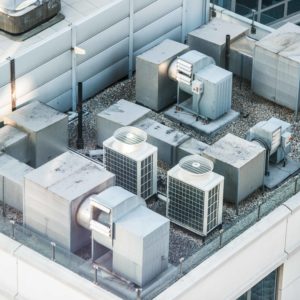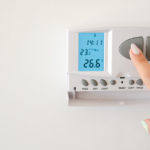 The occupants in any large building rarely see the HVAC equipment that keeps them warm or cool. They will notice grilles and diffusers, and sometimes the ducts, but the rest is out of sight in the basement or on the roof.
The occupants in any large building rarely see the HVAC equipment that keeps them warm or cool. They will notice grilles and diffusers, and sometimes the ducts, but the rest is out of sight in the basement or on the roof.
Generally, the decision about where to place HVAC equipment is made at the design stage of the structure. Next, it becomes a consideration when building operators think about replacing ageing HVAC. Today, almost half of the commercial buildings in the United States use rooftop units.
What are rooftop units?
Rooftop units (RTUs) have been around since the early 1900s. They were originally installed in urban neighborhoods where there wasn’t enough space between buildings to install air conditioners on the sides of the buildings.
RTUs can supply cooling, heat or both to the building, and with the addition of a humidistat, they can raise the humidity in the building. Known as package units, a rooftop unit consists of all coils, compressors and fans, which are housed in a cabinet installed outdoors.
Benefits of RTUs
Rooftop units are popular where real estate is at a premium, as they allow building operators to use the visible space better. When the alternative is a ground-level outdoor unit, choosing an RTU means there is more room for decorative plants and features on the grounds. When the alternative is an indoor unit, there is more space for people.
Rooftop units are modular, which means your customers can add new services. This can be valuable to customers who are, for example, planning an addition to their building. It may also be appealing for a commercial building where there may be changes in how space is used. Changes in use often mean different heating and cooling requirements.
The modules can be installed separately in several areas of the roof, allowing you to set up systems for specific areas of the building. For example, the south side of a building might require more cooling than the northern side.
Annual maintenance is also easier with rooftop units, as you need to access only one building location. RTUs are often less exposed to dirt and potential damage, which simplifies upkeep.
RTUs can be quieter than ground level units if they are installed correctly. Note that incorrectly installed RTUs can be considerably noisier than ground units.
The efficiency advantage
The most compelling argument for RTU installation is energy efficiency. RTUs make better use of outdoor air conditions by using economizers, which facilitate the use of outdoor air for cooling when conditions allow.
There are four different types of economizers:
A Dry Bulb Economizer has a sensor that detects when outdoor air can be used to cool the building. A damper opens, which allows the air to be used as return air.
A Single Enthalpy Economizer detects humidity levels that are acceptable to be used for cooling the building.
Differential Enthalpy Economizers measure the return air as well as the outdoor air and use dampers to optimize the system.
An Integrated Differential Economizer is similar to a differential system with the addition of communication with the thermostat.
Economizers are also used for ventilation. In buildings with carbon sensors, economizers will open dampers to bring fresh air into the building when carbon levels get too high, providing a cost-efficient way to improve indoor air quality.



